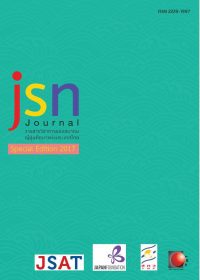The Shadowing Effect in Developing Accents for Japanese Loanwords in the Thai Language
Main Article Content
Abstract
Japanese loanwords are frequent in the Thai language, for example karate (คาราเต้), sumoo (ซูโม่), and sukiyaki (สุกี้ยากี้). Pronounced in Thai, these words’ phonological systems are in terms of tone different from the Japanese pitch accent. Thai students of Japanese find that their pronunciation of their native language interferes and causes problems when they speak Japanese. This paper aims to study the effect of the shadowing technique on improving the accent in Japanese loanwords in the Thai language. Correct Japanese accent patterns were used as analytical indicators. This study found that shadowing helped the Thai students learn the correct Japanese accent for Japanese loanwords in Thai. Improvement could be heard after three practice sessions of shadowing, compared to before practice. However, the shadowing effectiveness varied significantly after practice was discontinued for two weeks, where both improved and unimproved accents were found. The Japanese loanwords in Thai that were difficult for the Thai learners to improve with shadowing included เกี๊ยวซ่า (gyooza ○●●) ยากูซ่า (yakuza ●○○) and โชยุ (shooyu ○●●). The words that the students found difficult to pronounce included นัตโต (nattoo ○●●○), เทปปังยากิ (teppanyaki ○●●●●●) and เคนโด (kendoo ●○○○)
Article Details
ข้อความและข้อคิดเห็นต่างๆ ในบทความเป็นของผู้เขียนบทความนั้นๆ ไม่ใช่ความเห็นของกองบรรณาธิการหรือของวารสาร jsn Journal
References
ทัศนีย์ เมธาพิสิฐ. (2554). ผลการฝึกแชโดอิ้งต่อการพัฒนาทักษะการพูด: ด้านความเร็วและความถูกต้อง. วารสารวิชาการของเครือข่ายญี่ปุ่นศึกษา, 1(1), 78-89.
ยุพกา ฟูกุชิม่า. (2558). ประสิทธิผลของการฝึกแชโดอิ้งต่อการเรียนรู้เสียงสูงต่ำภาษาญี่ปุ่นของผู้เรียนชาวไทย. วารสารญี่ปุ่นศึกษา, 32(1), 79-90.
อัษฎายุทธ ชูศรี. (2555). คำยืมภาษาญี่ปุ่นในภาษาไทย. ใน การประชุมวิชาการระดับชาติเครือข่ายญี่ปุ่นศึกษาในประเทศไทย ครั้งที่ 5 มนุษยศาสตร์. (หน้า 189-207). ม.ป.ท.
อาลียา รัตนวิระกุล. (2555). กลยุทธ์การเรียนภาษาญี่ปุ่นของผู้เรียนชาวไทย: เปรียบเทียบระหว่างนักศึกษามหาวิทยาลัยและพนักงานบริษัท. ใน การประชุมวิชาการระดับชาติเครือข่ายญี่ปุ่นศึกษาในประเทศไทย ครั้งที่ 5 มนุษยศาสตร์. (หน้า 101-114). ม.ป.ท.
Siriphon Phaiboon, Y. (2006).『アクセント習得における意識的学習の役割-タイ語母語話者の場合』. 日本言語文化研究会論集 / 日本言語文化研究会 編:17-29.
秋永一枝. (1981).『明解日本語アクセント辞典』三省堂.
大久保雅子・神山由紀子・小西玲子・福井貴代美. (2013).『アクセント習得を促すシャドーイング実践―効果的な実践方法を目指して―』早稲田日本語教育実践研究 第1号:37-47.
唐澤麻里. (2010).『シャドーイングが日本語学習者にもたらす影響: 短期練習による発音面および学習者意識の観点から』お茶の水女子大学人文科学研究.
スィリポンパイブーン・ユパカー. (2009).『タイ語を母語とする日本語学習者におけるアクセント学習ストラテジーに関する研究 日本言語文化研究会論集 2009 年第5 号.
戸田貴子・大久保雅子. (2014). 『新しい音声教育実践における学習者の学び―オンデマンド併用授業による発音学習― 』 早稲田日本語教育学第16号.
戸田貴子. (2011). 『音声教育と日本語能力』 早稲田日本語教育学第9号.
[パッタラーパン・ブンナーク. (2014). 『日本語 ・ タイ語における外来語の受容について』 比較日本学教育研究センター.


